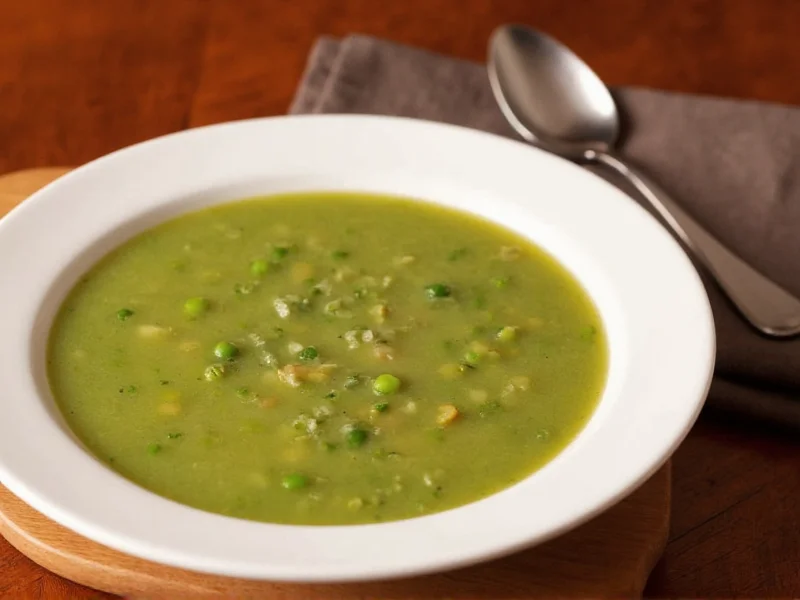The best pea soup recipe with ham bone combines 2 cups dried green split peas, 1 meaty ham bone, 6 cups water or broth, 1 diced onion, 2 chopped carrots, 2 chopped celery stalks, 2 minced garlic cloves, and bay leaves. Simmer for 1.5-2 hours until peas are tender and flavors meld, then remove ham bone, shred meat, and return to soup. This traditional recipe yields a thick, creamy, flavorful soup perfect for cold weather.
Why This Classic Pea Soup Recipe Stands Out
Pea soup with ham bone represents one of the most satisfying comfort foods, transforming simple pantry staples into a rich, hearty meal. The magic happens when the collagen-rich ham bone simmers with split peas, creating an unexpectedly creamy texture without dairy. This traditional method has sustained families through harsh winters for generations, making it both economical and deeply flavorful.The Secret Power of Ham Bone in Pea Soup
Many home cooks wonder why a ham bone makes such a dramatic difference compared to regular ham chunks. The answer lies in connective tissues and marrow. As the bone simmers, collagen breaks down into gelatin, which gives pea soup its signature velvety texture. The bone also contains concentrated flavor compounds that slowly infuse the broth, creating depth you can't achieve with pre-cooked ham alone.Essential Ingredients for Authentic Flavor
For the best traditional split pea soup with ham bone, gather these ingredients:| Ingredient | Quantity | Preparation Notes |
|---|---|---|
| Dried green split peas | 2 cups | Rinse thoroughly before use |
| Ham bone | 1 (about 1-1.5 lbs) | With some meat still attached |
| Yellow onion | 1 medium | Diced (about 1 cup) |
| Carrots | 2 medium | Chopped (about 1 cup) |
| Celery stalks | 2 | Chopped (about 1/2 cup) |
| Garlic | 2 cloves | Minced |
| Bay leaves | 2 | Remove before serving |
| Water or broth | 6 cups | Low-sodium if using store-bought |
Step-by-Step Cooking Instructions
Follow these steps for perfect homemade pea soup with smoked ham bone:- Prepare ingredients: Rinse split peas thoroughly under cold water, picking out any debris. Chop all vegetables uniformly for even cooking.
- Start the broth: Place ham bone in a large pot with 6 cups water or broth. Bring to a gentle boil, then reduce to simmer for 20 minutes to extract initial flavors.
- Add vegetables: Stir in onion, carrots, celery, and garlic. Simmer 10 minutes until vegetables begin softening.
- Incorporate peas: Add rinsed split peas and bay leaves. Return to a gentle simmer (not a rolling boil, which can make peas mushy).
- Slow simmer: Cover partially and cook for 1.5-2 hours, stirring occasionally. The soup is ready when peas have completely broken down and texture is thick and creamy.
- Finish preparation: Remove ham bone, shred any meat into bite-sized pieces, discarding fat and cartilage. Return meat to soup. Adjust seasoning with salt and pepper.
Cooking Time Breakdown
Understanding time requirements helps plan your cooking:- Prep time: 20 minutes (rinsing peas, chopping vegetables)
- Active cooking: 30 minutes (initial preparation and monitoring)
- Simmering time: 90-120 minutes (hands-off cooking)
- Total time: 2-2.5 hours (most is passive simmering)
Serving Suggestions for Maximum Enjoyment
This easy pea soup recipe with ham bone shines when served properly. Ladle hot soup into pre-warmed bowls. A sprinkle of fresh parsley adds color contrast against the earthy green soup. Crusty bread or cornbread provides the perfect vehicle for soaking up every last drop. For a traditional touch, serve with a side of mustard - the sharpness cuts through the soup's richness beautifully.Storage and Reheating Techniques
Pea soup actually improves overnight as flavors continue melding. Store cooled soup in airtight containers:- Refrigeration: Keeps well for 4-5 days. The soup will thicken considerably when chilled - simply add water or broth when reheating.
- Freezing: Excellent for up to 3 months. Freeze in portion-sized containers for easy single servings.
- Reheating: Warm gently over medium-low heat, stirring frequently. Avoid boiling, which can make the soup grainy.
Avoiding Common Pea Soup Mistakes
Even experienced cooks make these errors with pea soup recipe with ham bone:- Adding salt too early: Salt can toughen peas. Wait until the end of cooking to season properly.
- Boiling vigorously: A gentle simmer preserves texture. Rapid boiling makes peas disintegrate too much.
- Skipping the ham bone soak: That initial 20-minute simmer extracts maximum flavor from the bone.
- Using old split peas: Peas stored longer than a year may never soften properly. Buy fresh for best results.
Variations for Different Dietary Needs
This adaptable recipe works for various preferences:- Vegetarian version: Substitute ham bone with smoked paprika and liquid smoke for similar depth (though not identical flavor).
- Slow cooker method: After initial vegetable sauté, transfer everything to slow cooker and cook on low 6-8 hours.
- Thicker consistency: For a more traditional German-style pea soup, use less liquid (4 cups instead of 6).
- Extra vegetables: Add diced potatoes or parsnips during the last hour of cooking for additional heartiness.











 浙公网安备
33010002000092号
浙公网安备
33010002000092号 浙B2-20120091-4
浙B2-20120091-4